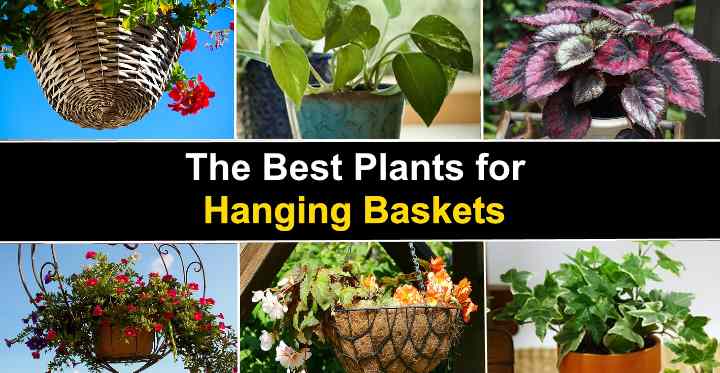Hanging baskets are an amazing addition to any space, whether indoors or out. Bright, vibrant blooms, dangling stems, and lush foliage are all characteristics of the best hanging basket plants. Annuals and perennials may be found in hanging basket plants, with some thriving in partial shade and others requiring full sun. Whatever kind of bloom you pick for your hanging basket, you’ll find that they’re exceedingly simple to maintain.
The best plants for hanging baskets are Beautiful dangling fuchsias, vibrant verbena, blooming petunias, and bushy flowering lobelia are among the flowering begonias. Trailing English ivy, tradescantias, golden pothos with their variegated leaves, and wax vines with their beautiful hanging blooms are some of the best hanging basket plants if you have a dim room.
You may have a stunning ball of colorful blooms depending on the type of plants in your hanging basket. Long, drooping stems that dangle down to the floor are another option. Some plants offer a spectacular of blooms and greenery that cascade down. As a result, there will be numerous hanging basket plants to choose from. You’ll learn how to choose the best hanging basket plants in this article. Care instructions for all varieties of hanging basket plants may also be found.
How to Choose the Best Plants for Hanging Baskets
There are a few things to consider before you start picking a plant to put in a basket. Successfully growing hanging baskets requires two key factors:
- Location
- Care requirements
Location iWhen picking the finest plants for hanging baskets, it’s typically one of the first things to consider. Will your hanging baskets be indoor or outdoor, for example? Consider how much sunlight the area receives if you want to have colorful blooms hanging on your porch or beside your door. You’ll need to pick appropriate tropical houseplants if your hanging basket plants are going to be indoors, far from direct sunlight.
You’ll also need to consider the needs of the plants in your basket. Pick specimens that need the same amount of care. Many tropical trailing plants, for example, need moist soil that never dries out or becomes soggy. Nevertheless, some blooming plants, such as those in the garden, need more frequent watering.
The Best Hanging Basket Plants
To lively up a room or add color to an outside space, which are the finest plants for hanging baskets? Read on to discover a wide range of hanging basket plants.
Golden Pothos (Epipremnum aureum)

Golden pothos is an attractive indoor hanging basket plant with long, trailing vines and green variegated leaves. The stems may grow up to 4 feet (1.2 meters) long, cascading down. In hanging baskets, where there is bright, indirect light, Pothos plants thrive.
In low-light circumstances, these houseplants grow well too, with the variegation less apparent. Pothos plants are excellent hanging plants for beginners because they are low-maintenance houseplants. Average room temperatures and moderate humidity are ideal for these lovely tropical plants.
Tradescantia

Tradescantias are the ideal hanging basket plant, often known as spiderwort, wandering Jew, or Indian paint. Indoors and outdoors, long dangling stems thrive. The colorful leaves of Tradescantias make them popular houseplants. Purple, green, or white are the colors of long or short elongated lanceolate leaves.
Variegation with colorful stripes can be seen on several leaves. If you grow it as a perennial evergreen, it blooms when the conditions are right.
These vining plants thrive in bright, indirect light, even though they may be placed in shady areas. To keep the plant looking its best, prune long straggly stems. Little blue flowers may be found on Tradescantias, however they may also be white, purple, or pink.
English Ivy (Hedera helix)
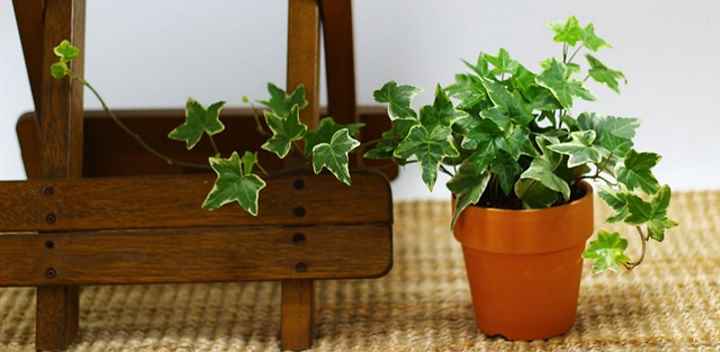
Ivy, commonly known as English ivy, is a trailing plant with long stems that cascade gently down the edge of hanging baskets. Ivy plants have light to dark green leaves with deeply lobed margins. Shade or low-light rooms are ideal for these low-light hanging basket plants. Ivy, a fast-growing houseplant that thrives in any indoor space, patio, or outdoor area, is another excellent addition to any setting.
Keep the soil moist and the air humid when growing English ivy in a hanging basket. Ivy is a kind of flowering plant that grows in the United Kingdom. It can be grown with other trailing blooming plants in baskets. If you prefer cascading green foliage, you can plant in hanging baskets with upward-growing flowers.
The ivy that grows across English is also on the list of best plants to clean the air. As a result, you may place the plant in your bedroom’s corner, where it thrives in low light.
Begonias

For low-light situations, begonias are excellent hanging basket plants. Begonias come in a variety of shapes, sizes, and colors. Many of them bloom throughout the growing season. The huge, showy flowers, drooping stems, and appealing characteristics of begonias have earned them a reputation. Ruffled double petals are seen in some of the showiest flowers. Yellow, pink, red, orange, or white blooms may be found.
For a splash of summer color, hang begonias on a front door, patio, or balcony. Filtered sunlight is ideal forBegonias. So, to protect them from the midday heat, put them in a south-facing position. You may get gorgeous flowers all summer if you keep trailing begonia plants in damp soil.
Creeping Jenny (Lysimachia nummularia)
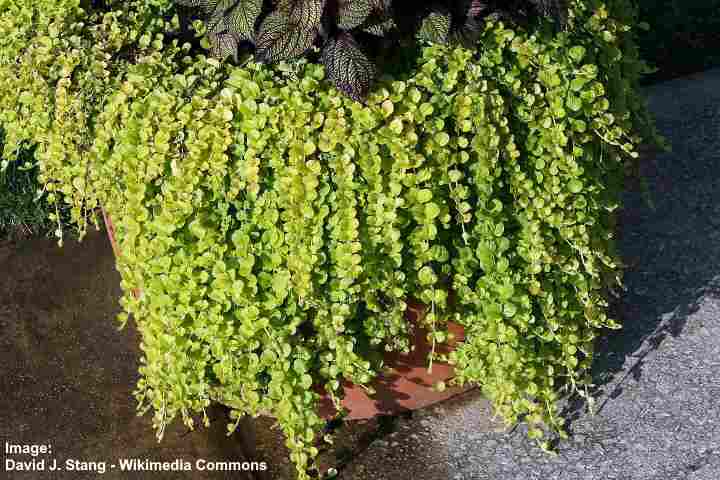
Creeping Jenny, a hanging basket plant with gorgeous leaves, is shown in the image. Little golden leaves can help compliment other blooming plants by spilling down the sides of baskets. Heart-shaped leaves and long dangling stems make up this perennial plant. The plant is also known as “Goldilocks” because of the regularly bright stems that trail behind it.
Jenny is best grown in full sun or partial shade. During the summer, small yellow blooms appear on the dangling plant, giving it a lovely appearance. Jenny is excellent for rock gardens or as a full-sun ground cover plant, in addition to being an fantastic hanging basket plant.
Wax Vines (Hoya)

Due to their lengthy gorgeous vines, wax plants (wax vines) are immensely popular in hanging baskets. Any shady nook receives a vertical boost from cascading waxy green leaves hanging baskets, pots, or urns. Hang these succulent plants in bright light, and the leaf colors will become more vibrant.
The hoya carnosa, sometimes known as the Hindu rope plant, is a popular evergreen hanging basket plant. The stems of this plant are long and slender, with thick crinkly leaves. Beautiful porcelain-like blooms draping over the sides of the basket will reward you if you care well for your hoya.
Donkey’s Tails (Sedum morganianum)
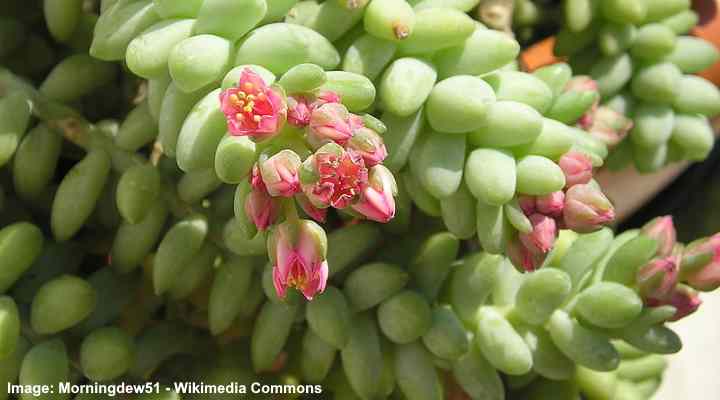
The dangling vines of this vining succulent gently dangle over the sides of hanging baskets, and they’re also known as burro’s tails. With tiny thick fleshy leaves, this succulent is a drought-tolerant houseplant. The long stalks hang down vertically and are up to 24 inches (60 cm) long, with succulent gray-green leaves.
Full sunlight is best for Donkey’s tails. This type of succulent needs critical care because it does not water excessively. One of the coolest and most distinctive plants available for growing outdoors or indoors is Burro’s tails plant.
String of Hearts (Ceropegia woodii)
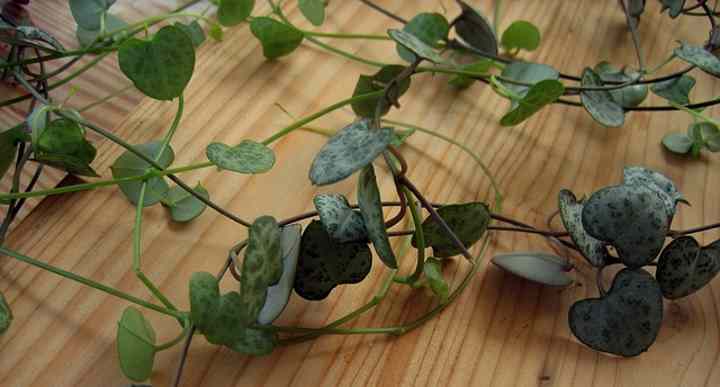
The slender stems resemble strings of thread with heart-shaped leaves, making it simple to see why this tropical hanging basket plant is called the “string of hearts.” The plant’s other names include “string of hearts,” “hearts-on-a-string,” and “sweetheart vine.”
When it is in a sunny area, the leaves turn vividly variegated. At the base of the tubular flowers is a ball-like shape. Due to its beautiful leaves, this plant is often maintained as a hanging basket plant.
String of Dolphins (Senecio peregrinus)

Because it is difficult to locate, the “String of Dolphins” is a uncommon plant. Succulent leaves resembling tiny dolphins leaping out of the sea dangle from the draping stems. Keep this plant in a hanging basket in a bright, sunny position if you are lucky enough to find it.
When the soil dries out, it’s the only water source. The unusual plant will reward you for caring for a group of dolphins correctly with delicate flowers. From May through June, delicate white blooms with a distinctive cinnamon scent bloom.
Lipstick Plant (Aeschynanthus)

Perfect for hanging baskets in rooms with bright, indirect light, the lipstick plant is an easy-to-care-for plant. Green lanceolate leaves adorn the trailing vines. The hanging plant blossoms produce a variety of deep red, orange, or yellow blooms when it blooms. Lipstick plant flowers look like little tubes of lipstick, which is unusual.
This tropical draping plant thrives in bright environments. The plant won’t bloom if there isn’t enough light. It requires moist soil that never becomes too soggy for the plant to thrive. Dangling stems with curled or twisted leaves are seen on certain lipstick plant cultivars.
Radiator Plants (Peperomia)

The Peperomia genus is one of the most popular houseplants for hanging baskets, as seen in the photograph. If you don’t have a lot of space to display your radiator plants, they’re great compact plants. The ground-cover types of peperomia are the most suitable for hanging baskets.
They have slender leaves and long, spreading stems. Thread-like stems expand out from the bottom of baskets, gradually draping over the edge to occupy vertical space.
Indoor blooming of Peperomia plants is rare. If you want lush, bushy foliage to accompany blooming plants, these plants are the ideal companion plants for hanging baskets. If you want your plant to make an impression hanging in a room, pick a variegated peperomia variety.
Heartleaf Philodendron (Philodendron hederaceum)
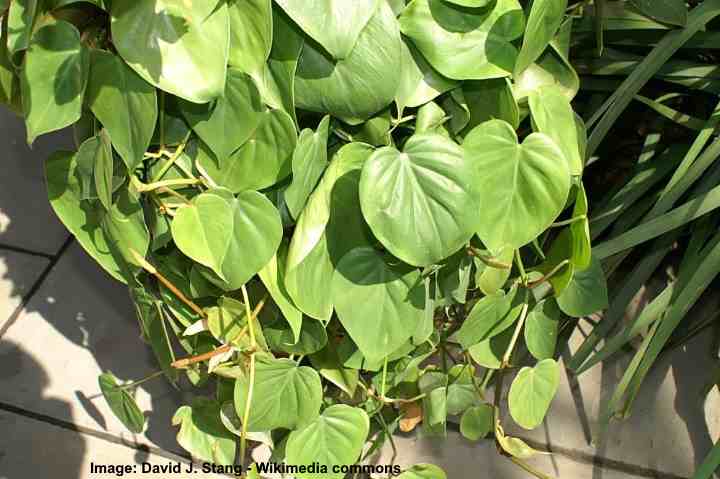
Heartleaf philodendrons’ unbranched climbing stems droop down from hanging baskets’ sides. In any living environment, the spectacular big, glossy green leaves have an immediate effect. The leaves, which may grow up to 4 inches (10 cm) long, are heart-shaped, as the common name implies.
The trailing stems of philodendron plants can become straggly in dark places and low-light settings. Keep the hanging basket plant in bright but not direct sunlight to maintain it. The list of caring for hanging houseplants includes Philodendron.
Strawberry Begonia (Saxifraga stolonifera)

For hanging baskets, strawberry begonias are lovely. The plant produces lovely trailing foliage by producing runners that trail over the edge of pots. The reddish-plum hues on the underside of the leaves are an remarkable characteristic of these indoor plants. The plant produces little white blooms throughout the summer.
In warm, humid climates with adequate ventilation, grow these indoor hanging basket plants. The roots of the stems have clumps of plantlets, similar to spider plants (which are also excellent hanging basket plants).
Creeping Charlie (Glechoma hederacea)
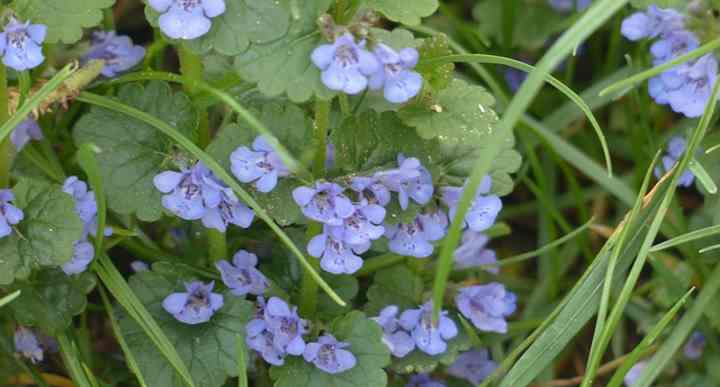
Creepy Charlie, a fast-growing type of ivy that grows on walls, is a common hanging basket plant. A dense hanging basket plant is created by cascading thick creeping foliage over the side of plant pots. Light to dark green colors with some white variegation are seen on the attractive leaves.
To give roomy green leaves, hang this flowering ivy plant near doors or in patios. Hang the pots in full or partial sunlight. Attractive blue funnel-shaped blooms bloom in mid- to late-spring to add color.
Watermelon Begonia (Pellionia pulchra)
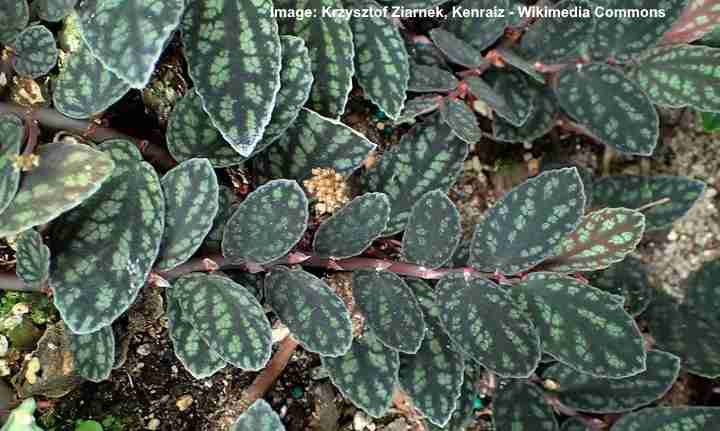
Bushy, trailing plants that grow in hanging baskets are known as watermelon begonias. These plants prefer to grow in shaded or dimmed environments. The spreading foliage may lead to dense trailing stems under the appropriate circumstances. The green and white marbling pattern on the delicate leaves is stunning.
The leaves of some varieties have purple veins. Since they need a lot of humidity, these aren’t low-maintenance plants. So, periodically spray or use a humidifier if you have one of these plants hananging in a dark corner.
Flowering Hanging Basket Plants

Geranium, fuchsia, and lobelia are examples of plants that prefer bright locations and create a profusion of colorful blooms. After that, here are five categories of low-maintenance outdoor hanging basket plants.
Fuchsias—Since their flowers dangle down, trailing plants are ideal for hanging baskets. Fuchsia blooms range in color from pinks, purples, and whites and resemble tiny bells.
Petunias—Due to the large number of colorful flowers, petunias in hanging baskets will create a colorful bushy ball. One of the best blooming plants for hanging baskets is Petunias. To help these plants thrive, hang them in a bright sunny spot.
Lobelia—The entire plant turns into a display of richly coloured blue or purple blooms when lobelia blooms in a hanging basket. In a patio, balcony, or beside a door that gets partial shade, hang lobelia plants. For the best results, keep the soil moist.
Verbena—Outdoors in full sun, these plants make a wonderful hanging basket option. During the season, vast numbers of colorful flower clusters bloom. White, red, purple, pink, and multicolored blooms are all expected.
Geranium—Since they prefer bright sunlight, these are popular plants for hanging in containers. Hangable baskets on a south-facing deck or construction are perfect for these blossoms. In partial shade, geraniums will bloom abundantly. Throughout the season, abundant blooms hang down from the containers. Bring them in during the winter to keep them safe from the cold.
Caring for Flowers in Hanging Baskets
Only water when the soil is somewhat dry, and keep the soil moist, but not waterlogged, to look after hanging basket blooming plants. Fertilize when the soil is moist, according to the plant’s needs. To encourage growth and blooming, deadhead the flowers as needed.
Remove straggly dangling trailing stems from the basket to prune leggy ones. According to plant experts, keeping the soil moist is critical for hanging basket plants during the summer. Only water the plants when the top inch of soil is dry. Before it drains out of the basket, deep watering requires pouring in enough water.
When the top one inch (2.5 cm) of soil is dry, water indoor hanging basket plants. Run enough water through the soil until it drains out the bottom after taking the plant to the bath or sink.
How to Plant Hanging Basket Plants
Your hanging basket plants will also thrive if you find a suitable container, pot, or basket to hang them in. Baskets should be approximately 14 to 16 inches (35 to 40 cm) broad. This pot size allows you to create a stunning floral display by growing a few plants together.
You’ll also need to put a liner in the hanging basket before you plant any plants. Coco coir (coconut fiber) liners are the most effective. Make sure that your plants will survive in the hanging basket by using a well-draining soil.
